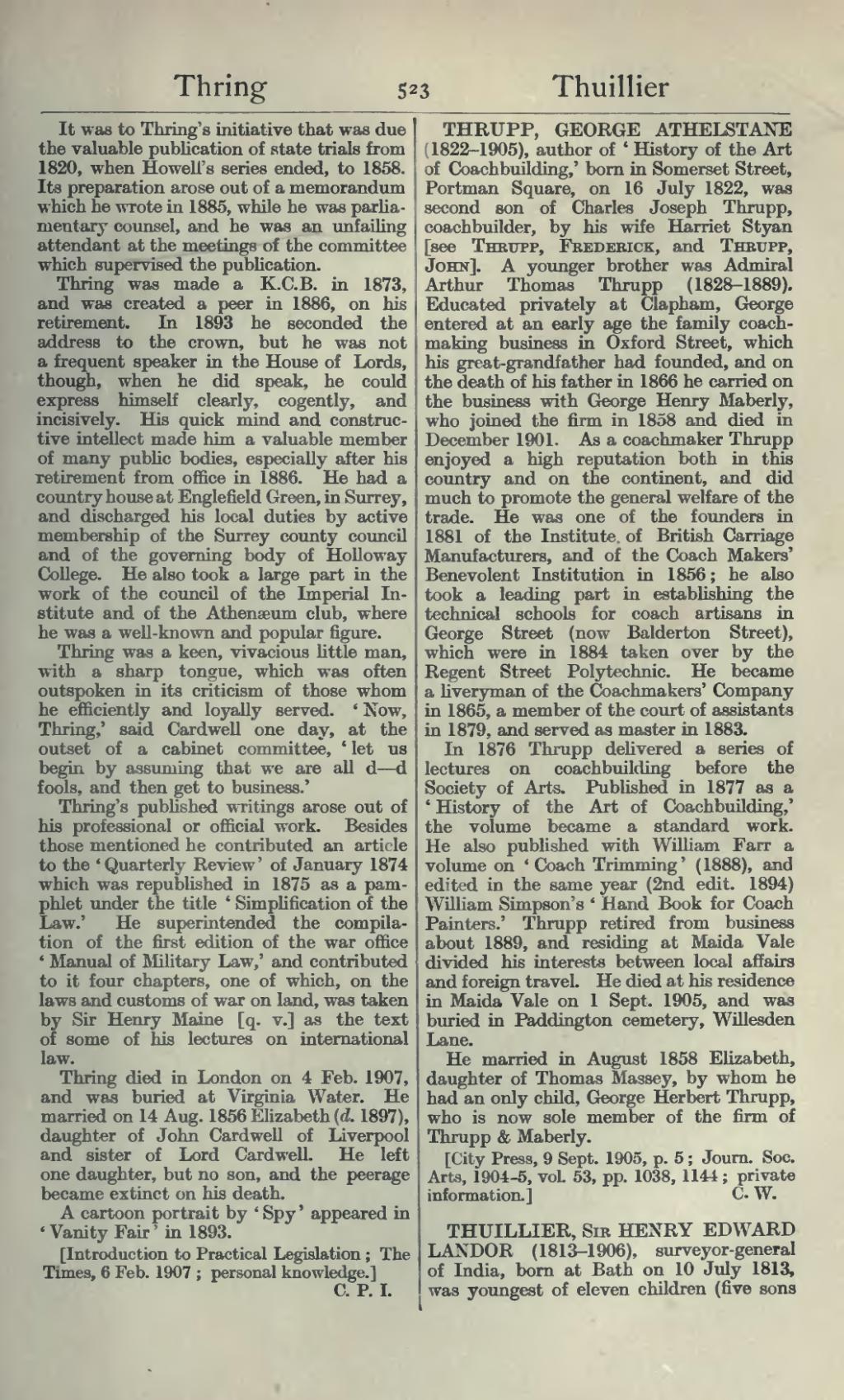It was to Thring's initiative that was due the valuable publication of state trials from 1820, when Howell's series ended, to 1858. Its preparation arose out of a memorandum which he wrote in 1885, while he was parliamentary counsel, and he was an unfailing attendant at the meetings of the committee which supervised the publication.
Thring was made a K.C.B. in 1873, and was created a peer in 1886, on his retirement. In 1893 he seconded the address to the crown, but he was not a frequent speaker in the House of Lords, though, when he did speak, he could express himself clearly, cogently, and incisively. His quick mind and constructive intellect made him a valuable member of many public bodies, especially after his retirement from office in 1886. He had a country house at Englefield Green, in Surrey, and discharged his local duties by active membership of the Surrey county council and of the governing body of Holloway College. He also took a large part in the work of the council of the Imperial Institute and of the Athenæum club, where he was a well-known and popular figure.
Thring was a keen, vivacious little man, with a sharp tongue, which was often outspoken in its criticism of those whom he efficiently and loyally served. 'Now, Thring,' said Cardwell one day, at the outset of a cabinet committee, 'let us begin, by assuming that we are all d — d fools, and then get to business.'
Thring's published writings arose out of his professional or official work. Besides those mentioned he contributed an article to the 'Quarterly Review' of January 1874 which was republished in 1875 as a pamphlet under the title ' Simphfication of the Law.' He superintended the compilation of the first edition of the war office 'Manual of Military Law,' and contributed to it four chapters, one of which, on the laws and customs of war on land, was taken by Sir Henry Maine [q. v.] as the text of some of his lectures on international law.
Thring died in London on 4 Feb. 1907, and was buried at Virginia Water. He married on 14 Aug. 1856 Elizabeth (d. 1897), daughter of John Cardwell of Liverpool and sister of Lord Cardwell. He left one daughter, but no son, and the peerage became extinct on his death.
A cartoon portrait by 'Spy' appeared in 'Vanity Fair' in 1893.
[Introduction to Practical Legislation; The Times, 6 Feb. 1907; personal knowledge.]
THRUPP, GEORGE ATHELSTANE (1822–1905), author of 'History of the Art of Coachbuilding,' born in Somerset Street, Portman Square, on 16 July 1822, was second son of Charles Joseph Thrupp, coachbuilder, by his wife Harriet Styan [see Thrupp, Frederick, and Thrupp, John]. A younger brother was Admiral Arthur Thomas Thrupp (1828–1889). Educated privately at Clapham, George entered at an early age the family coach-making business in Oxford Street, which his great-grandfather had founded, and on the death of his father in 1866 he carried on the business with George Henry Maberly, who joined the firm in 1858 and died in December 1901. As a coachmaker Thrupp enjoyed a high reputation both in this country and on the continent, and did much to promote the general welfare of the trade. He was one of the founders in 1881 of the Institute, of British Carriage Manufacturers, and of the Coach Makers'
Benevolent Institution in 1856; he also took a leading part in establishing the technical schools for coach artisans in George Street (now Balderton Street), which were in 1884 taken over by the Regent Street Polytechnic. He became a liveryman of the Coachmakers' Company in 1865, a member of the court of assistants in 1879, and served as master in 1883.
In 1876 Thrupp delivered a series of lectures on coachbuilding before the Society of Arts. Published in 1877 as a 'History of the Art of Coachbuilding,' the volume became a standard work. He also published with William Farr a volume on 'Coach Trimming' (1888), and edited in the same year (2nd edit. 1894) William Simpson's 'Hand Book for Coach Painters.' Thrupp retired from business about 1889, and residing at Maida Vale divided his interests between local affairs and foreign travel. He died at his residence in Maida Vale on 1 Sept. 1905, and was buried in Paddington cemetery, Willesden Lane.
He married in August 1858 Elizabeth, daughter of Thomas Massey, by whom he had an only child, George Herbert Thrupp, who is now sole member of the firm of Thrupp & Maberly.
[City Press, 9 Sept. 1905, p. 5; Journ. Soc. Arts, 1904-5, vol. 53, pp. 1038, 1144; private information.]
THUILLIER, Sir HENRY EDWARD LANDOR (1813–1906), surveyor-general of India, born at Bath on 10 July 1813, was youngest of eleven children (five sons
